warning FIAT ULYSSE 2008 2.G Owner's Guide
[x] Cancel search | Manufacturer: FIAT, Model Year: 2008, Model line: ULYSSE, Model: FIAT ULYSSE 2008 2.GPages: 254, PDF Size: 3.46 MB
Page 133 of 254
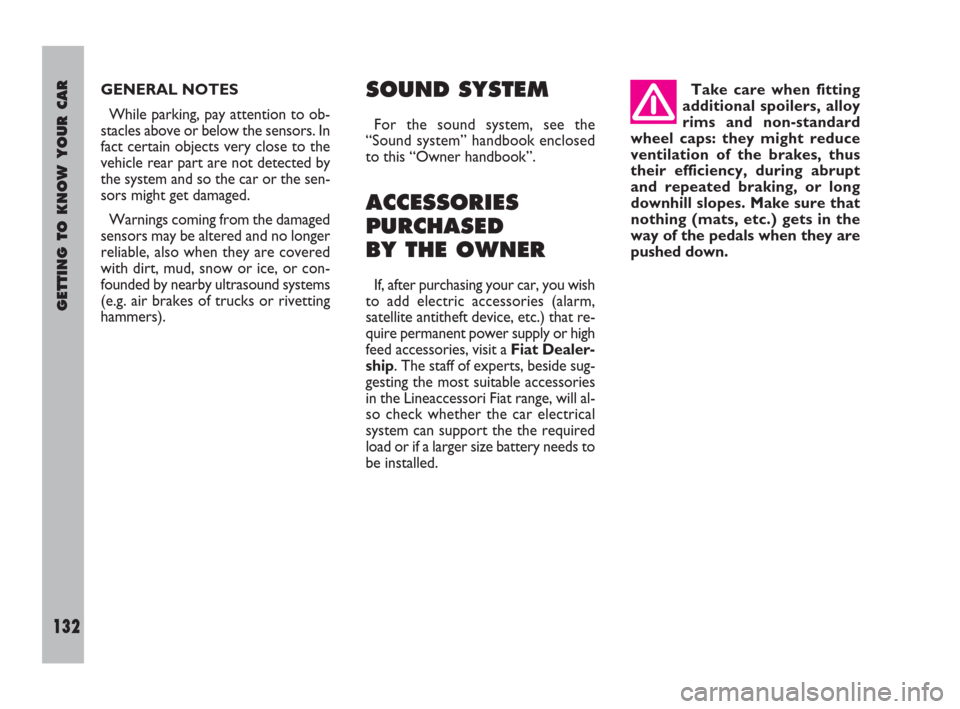
GETTING TO KNOW YOUR CAR
132
GENERAL NOTES
While parking, pay attention to ob-
stacles above or below the sensors. In
fact certain objects very close to the
vehicle rear part are not detected by
the system and so the car or the sen-
sors might get damaged.
Warnings coming from the damaged
sensors may be altered and no longer
reliable, also when they are covered
with dirt, mud, snow or ice, or con-
founded by nearby ultrasound systems
(e.g. air brakes of trucks or rivetting
hammers).SOUND SYSTEM
For the sound system, see the
“Sound system” handbook enclosed
to this “Owner handbook”.
ACCESSORIES
PURCHASED
BY THE OWNER
If, after purchasing your car, you wish
to add electric accessories (alarm,
satellite antitheft device, etc.) that re-
quire permanent power supply or high
feed accessories, visit a Fiat Dealer-
ship. The staff of experts, beside sug-
gesting the most suitable accessories
in the Lineaccessori Fiat range, will al-
so check whether the car electrical
system can support the the required
load or if a larger size battery needs to
be installed.Take care when fitting
additional spoilers, alloy
rims and non-standard
wheel caps: they might reduce
ventilation of the brakes, thus
their efficiency, during abrupt
and repeated braking, or long
downhill slopes. Make sure that
nothing (mats, etc.) gets in the
way of the pedals when they are
pushed down.
Page 138 of 254
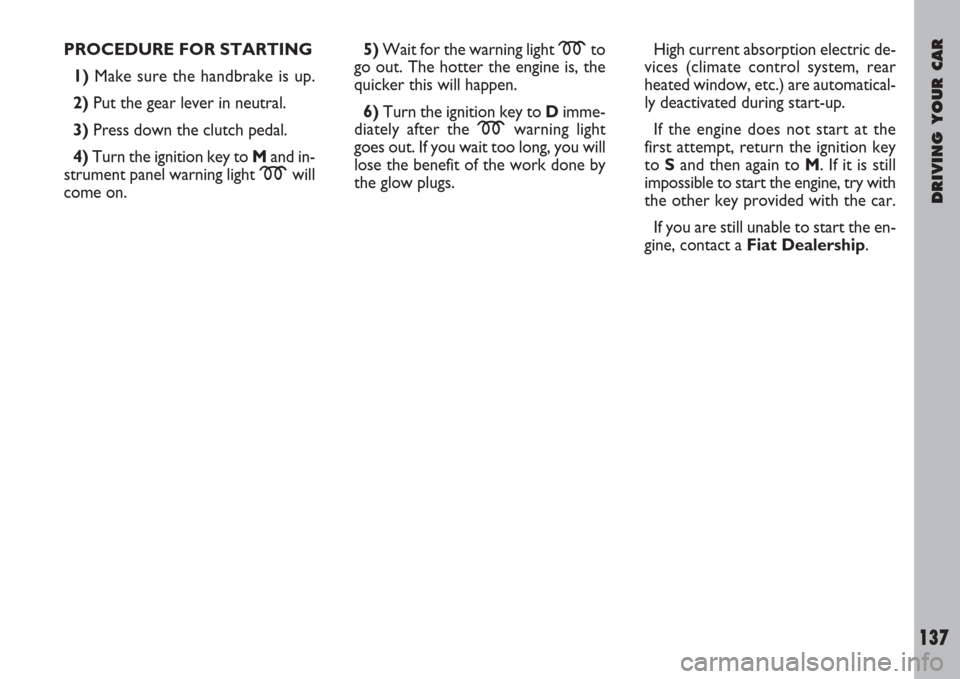
DRIVING YOUR CAR
137
5)Wait for the warning light mto
go out. The hotter the engine is, the
quicker this will happen.
6)Turn the ignition key to Dimme-
diately after the mwarning light
goes out. If you wait too long, you will
lose the benefit of the work done by
the glow plugs. PROCEDURE FOR STARTING
1)Make sure the handbrake is up.
2)Put the gear lever in neutral.
3) Press down the clutch pedal.
4)Turn the ignition key to Mand in-
strument panel warning light mwill
come on.High current absorption electric de-
vices (climate control system, rear
heated window, etc.) are automatical-
ly deactivated during start-up.
If the engine does not start at the
first attempt, return the ignition key
to Sand then again to M. If it is still
impossible to start the engine, try with
the other key provided with the car.
If you are still unable to start the en-
gine, contact a Fiat Dealership.
Page 148 of 254

DRIVING YOUR CAR
147
CHEAP RUNNING THAT RESPECTS
THE ENVIRONMENT
LOOKING AFTER EMISSION
CONTROL DEVICES
The correct use of pollution control
devices not only ensures respect for
the environment but also has an effect
on the car’s performance. Keeping
these devices in good condition is
therefore a fundamental rule for dri-
ving that is easy on your pocket and
on the environment too.
The first step to take is to follow the
Service Schedule to the letter.
Only use diesel for motor vehicles
(EN590 specification). Environmental protection has been
one of the guiding principles in the
production of the Ulysse. It is no ac-
cident that its pollution control equip-
ment is much more effective than that
required by current legislation.
Nonetheless, the environment can-
not get by without a concerted effort
from everyone.
By following a few simple rules the
motorist can avoid harming the envi-
ronment and often cut down fuel con-
sumption at the same time.
On this subject, a number of useful
tips have been given below to supple-
ment those marked by symbol
#, at
various points of the manual.
You are asked to read both the for-
mer and latter carefully.If you have trouble starting, do not
turn the ignition key for long periods.
Be especially careful to avoid bump
starting the vehicle by pushing, towing
or rolling downhill: these are all ma-
noeuvres that can damage the catalyt-
ic exhaust.
For emergency starts only use an
auxiliary battery.
If the engine begins to “lose its
smoothness” when travelling, contin-
ue your journey but reduce the de-
mands you are making on the engine
and have the vehicle checked at a Fi-
at Dealership.
When the instrument panel fuel re-
serve warning light comes on, fill up as
soon as possible. A fuel level that is
too low can cause an uneven supply of
fuel with the inevitable increase in ex-
haust temperature; this would seri-
ously damage the catalytic converter.
Page 155 of 254
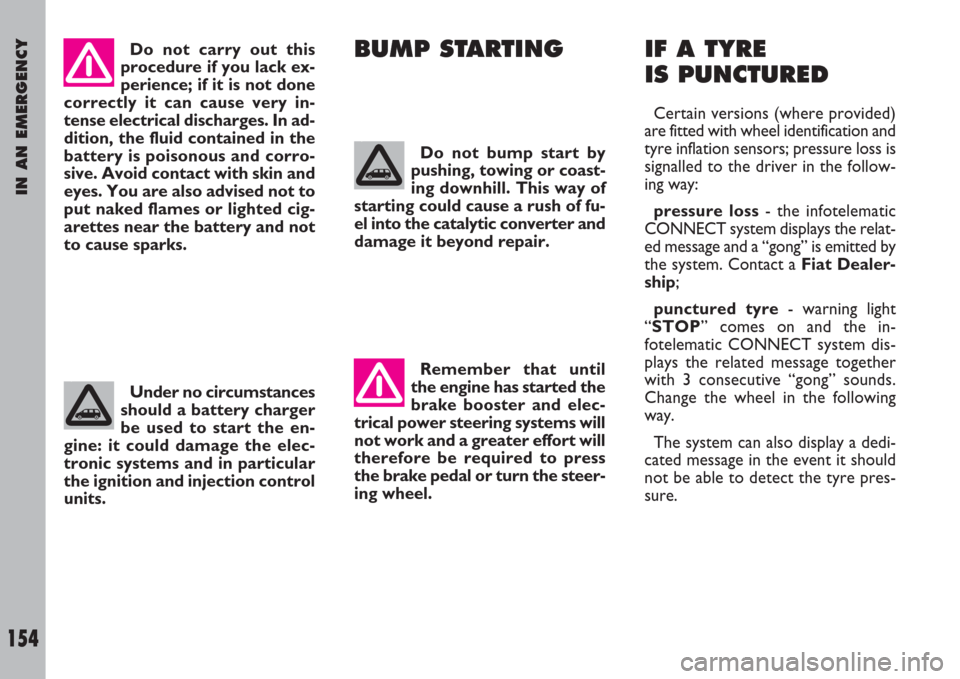
IN AN EMERGENCY
154
Do not carry out this
procedure if you lack ex-
perience; if it is not done
correctly it can cause very in-
tense electrical discharges. In ad-
dition, the fluid contained in the
battery is poisonous and corro-
sive. Avoid contact with skin and
eyes. You are also advised not to
put naked flames or lighted cig-
arettes near the battery and not
to cause sparks.
Remember that until
the engine has started the
brake booster and elec-
trical power steering systems will
not work and a greater effort will
therefore be required to press
the brake pedal or turn the steer-
ing wheel.IF A TYRE
IS PUNCTURED
Certain versions (where provided)
are fitted with wheel identification and
tyre inflation sensors; pressure loss is
signalled to the driver in the follow-
ing way:
pressure loss- the infotelematic
CONNECT system displays the relat-
ed message and a “gong” is emitted by
the system. Contact a Fiat Dealer-
ship;
punctured tyre- warning light
“STOP” comes on and the in-
fotelematic CONNECT system dis-
plays the related message together
with 3 consecutive “gong” sounds.
Change the wheel in the following
way.
The system can also display a dedi-
cated message in the event it should
not be able to detect the tyre pres-
sure. Under no circumstances
should a battery charger
be used to start the en-
gine: it could damage the elec-
tronic systems and in particular
the ignition and injection control
units.
BUMP STARTING
Do not bump start by
pushing, towing or coast-
ing downhill. This way of
starting could cause a rush of fu-
el into the catalytic converter and
damage it beyond repair.
Page 186 of 254

SERVICE SCHEDULE
30 60 90 120 150 180
●●●●●●
●●●●●●
●●●●●●
●●●●●●
●●●●●●
●●●
●●●●●●
●●●●●●
●●●●●●
●●●
●●●●●●
●●●
●
●●●●●●
CAR MAINTENANCE
185
Thousands of kilometres
Check tyre conditions/wear and adjust pressure if required
Check light system operation
(headlights, direction indicators, hazard lights, boot lights, passenger
compartment lights, glovebox lights, warning lights, horn)
Check windscreen wiper/washer operation, adjust nozzles if required
Check windscreen/rear window blade position/wear
Check front disk brake pad conditions and wear and pad wear
indicator operation
Check rear disk brake pad conditions and wear
Sight inspect the conditions of: body external parts, underbody protection, pipes
and hoses (exhaust - fuel - brakes), rubber parts (boots, sleeves, bushes, etc.)
Check cleanness of locks, bonnet and boot and lever cleanness and lubrication
Check and top up, if required, fluid levels (brakes/hydraulic clutch,
windscreen/rear window washer, battery, engine coolant, etc.)
Check and adjust handbrake lever stroke, if required
Sight inspect accessory drive belt conditions
Check accessory drive belt tension (for engines without automatic belt tightener)
Sight inspect timing belt conditions
Check exhaust emissions/smoke
Page 236 of 254

RIGHT-HAND DRIVE VERSIONS
235
1.Side vents
2.Passenger air bag
3.Sound system/Infotelematic Connect system (where
fitted)
4.Sound system/Infotelematic Connect system display
(where fitted)
5.Revolution counter
6.Speedometer
7.Fuel gauge with low fuel warning light and engine
coolant temperature gauge with warning light showing
when the temperature is too high
8.Central vents
9.Gear lever
10.Left-hand stalk: headlight control
11.Horn
12.Instrument panel: odometer display and warning lights
13.Right-hand stalk, windscreen washer, rear window
washer and trip computer14.ASR system on/off.
15.Headlight beam adjuster (Xeno light versions excluded)
16.Sound system controls on steering wheel
17.Ignition switch
18.Driver air bag
19.Document compartment
20.Cruise control control lever
21.Ashtray and glove compartment
22.Console
23.Glove compartment/Infotelematic Connect system re-
mote controls (where fitted)
24.Cigar lighter
25.Hazard lights
26.Climate system automatic controls
27.Glove compartment
Page 237 of 254
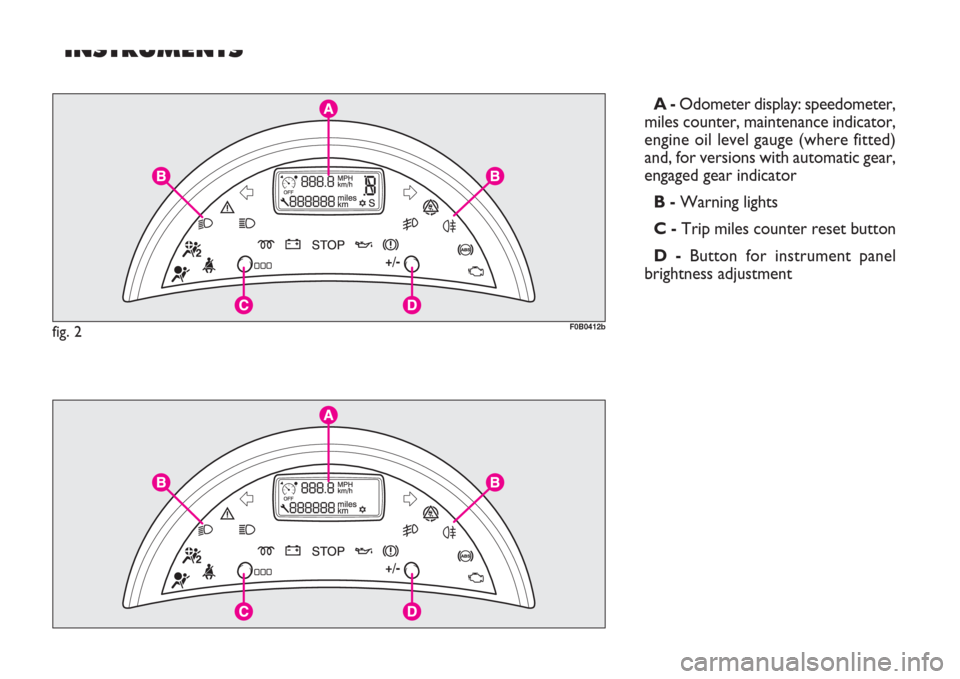
RIGHT-HAND DRIVE VERSIONS
236
INSTRUMENTS
A -Odometer display: speedometer,
miles counter, maintenance indicator,
engine oil level gauge (where fitted)
and, for versions with automatic gear,
engaged gear indicator
B -Warning lights
C -Trip miles counter reset button
D -Button for instrument panel
brightness adjustment
fig. 2F0B0412b
fig. 3F0B0413b
Page 238 of 254
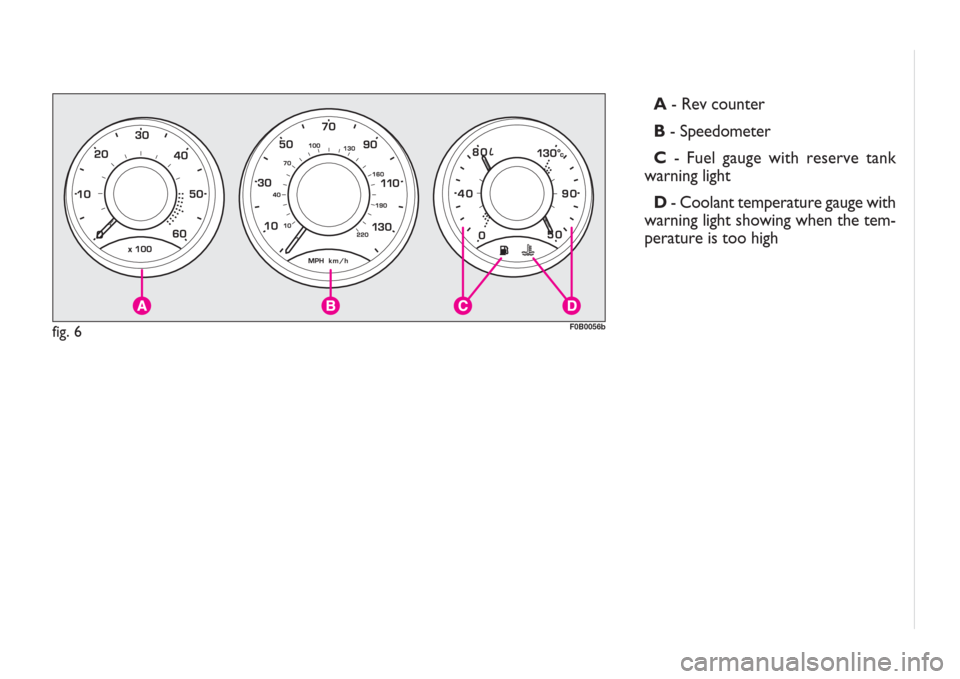
RIGHT-HAND DRIVE VERSIONS
237
A - Rev counter
B- Speedometer
C- Fuel gauge with reserve tank
warning light
D- Coolant temperature gauge with
warning light showing when the tem-
perature is too high
fig. 6F0B0056b
Page 239 of 254
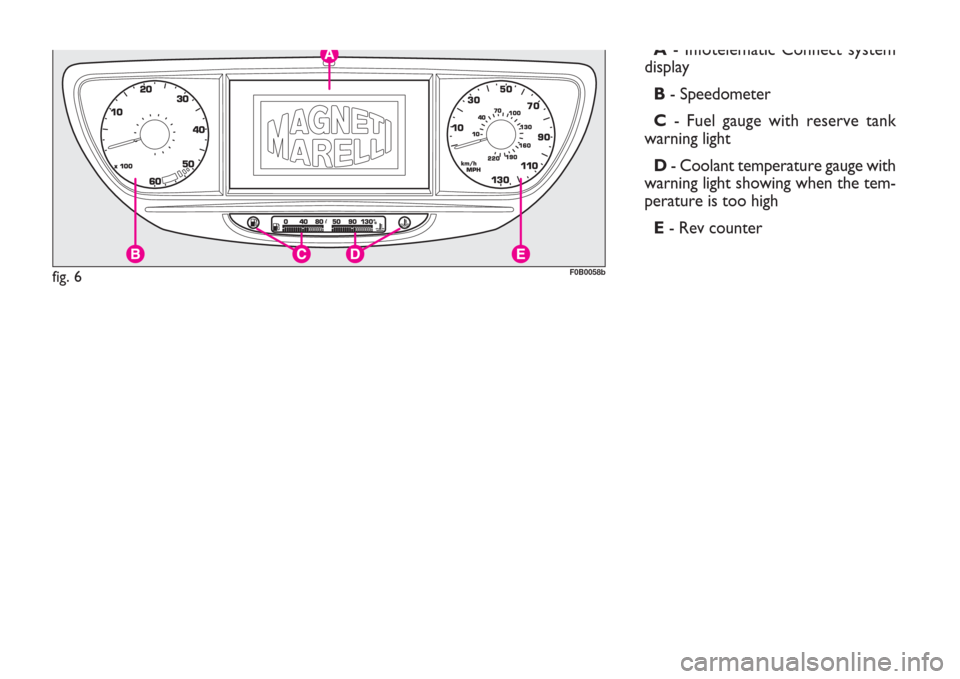
RIGHT-HAND DRIVE VERSIONS
238
A- Infotelematic Connect system
display
B- Speedometer
C- Fuel gauge with reserve tank
warning light
D- Coolant temperature gauge with
warning light showing when the tem-
perature is too high
E- Rev counter
fig. 6F0B0058b
Page 240 of 254
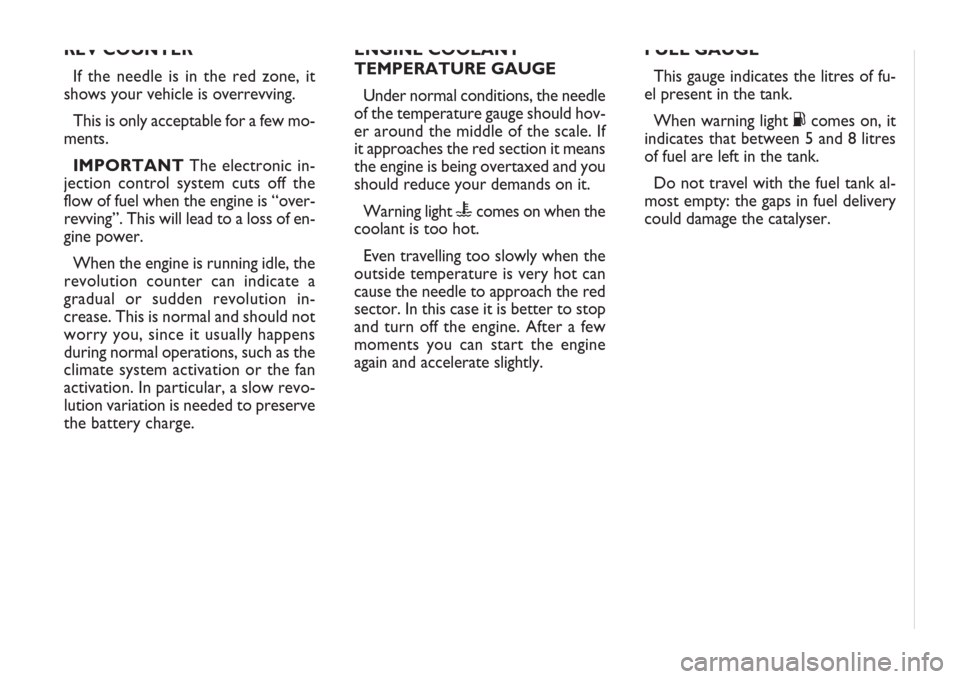
RIGHT-HAND DRIVE VERSIONS
239
ENGINE COOLANT
TEMPERATURE GAUGE
Under normal conditions, the needle
of the temperature gauge should hov-
er around the middle of the scale. If
it approaches the red section it means
the engine is being overtaxed and you
should reduce your demands on it.
Warning light
ucomes on when the
coolant is too hot.
Even travelling too slowly when the
outside temperature is very hot can
cause the needle to approach the red
sector. In this case it is better to stop
and turn off the engine. After a few
moments you can start the engine
again and accelerate slightly. REV COUNTER
If the needle is in the red zone, it
shows your vehicle is overrevving.
This is only acceptable for a few mo-
ments.
IMPORTANTThe electronic in-
jection control system cuts off the
flow of fuel when the engine is “over-
revving”. This will lead to a loss of en-
gine power.
When the engine is running idle, the
revolution counter can indicate a
gradual or sudden revolution in-
crease. This is normal and should not
worry you, since it usually happens
during normal operations, such as the
climate system activation or the fan
activation. In particular, a slow revo-
lution variation is needed to preserve
the battery charge.FUEL GAUGE
This gauge indicates the litres of fu-
el present in the tank.
When warning light Kcomes on, it
indicates that between 5 and 8 litres
of fuel are left in the tank.
Do not travel with the fuel tank al-
most empty: the gaps in fuel delivery
could damage the catalyser.